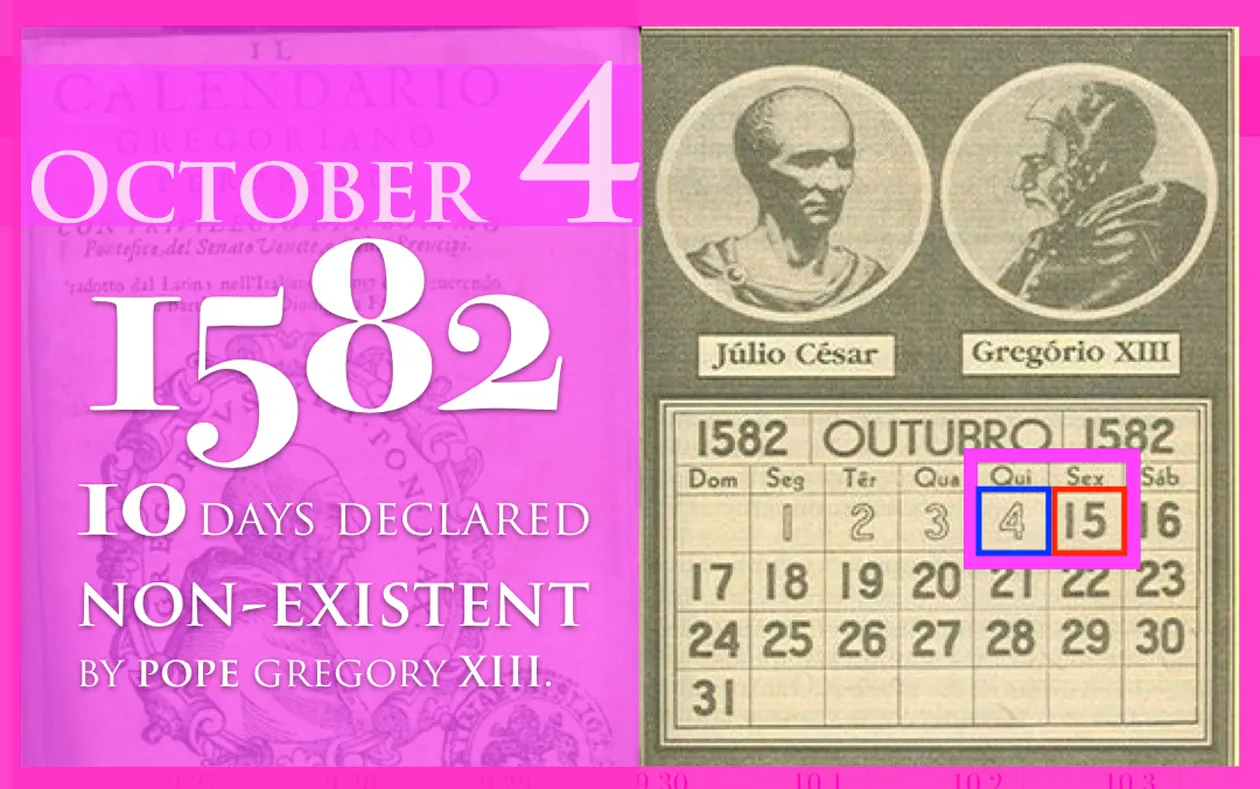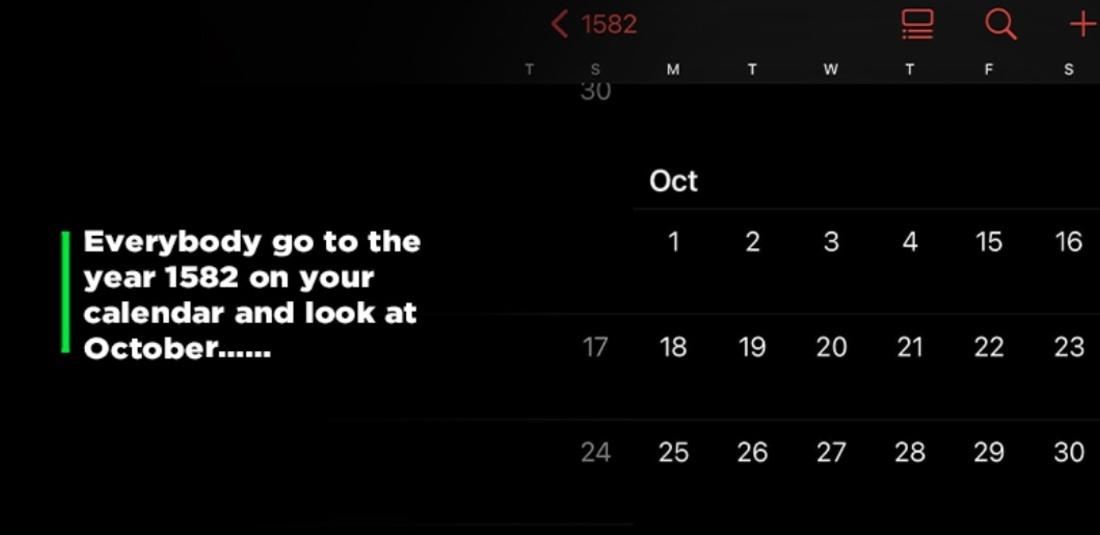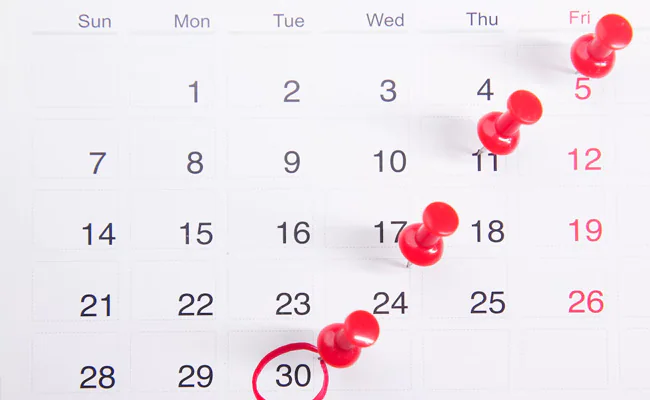What Happened To Calendar In October 1582?
From measuring time through sundials to achieving accuracy with the invention of calendars, the world witnessed a revolutionary change with the introduction of the Gregorian calendars. However, as the old saying goes, to err is human. Sometime back, some curious minds unravelled a mystery that was right in front of eyes but went unnoticed for a very long time.

Did you know that there was something wrong with October 1582? Well, if not, run through the then-calendar and you’d know the biggest blunder, which was made whilst penning down the month. Internet users were shocked to learn that some days completely vanished from the said month and here’s the reason why it all happened.
What Happened To Calendar In Oct. 1582?

Sometime back in November, a post appeared on Facebook, “Bro go to your calendar and go to October of 1582.” The words were soon picked up by many inquisitive minds and social media platforms like Twitter started buzzing with surprise. The bizarre mystery behind the vanished days gained momentum and people began to find answers about a grave error in the calendar.
Social media was instantly flooded with bizarre theories regarding the dramatic issue in the Oct. 1582 calendar. Some even went to the extent of forwarding conspiracy theories like there was a glitch in the matrix, time stopped or the world experienced some sort of an apocalypse for a while. But none of that is true!
No 5,6,7,8,9,10,11,12,13 & 14 pic.twitter.com/TtLI8CuaUk
— Tha Real Bello (@ThaRealBello) November 15, 2022
One wrote, “Can somebody explain October in the year 1582? time is not real.” Another called it “weird as hell” and wrote, “This Shit Is Weird As Hell… Nov 1st Starts Monday But Oct 31 Ends On Wednesday. But Looking At The 12 Months, Oct Has 31 Days Until You Tap On The Month Then Some Days Disappear… Wtfffffffff…..” One curious user asked on Twitter, “Can somebody explain October in the year 1582? time is not real.”
If you still haven’t turned in the pages, let me tell you that in 1582, October 4 is proceeded by October 15. As bizarre as it may sound, it’s true! So what happened to the 10 days in between? Well, the good news is that this mystery has been solved.
Wow…. We are practically living in an illusion.????
— Flawless????????????????????️???? (@flawless_gal) November 16, 2022
American astrophysicist and science communicator Neil deGrasse Tyson explained the matter in the best possible way. He stated, “By 1582, the Julian calendar, with a Leap Day every four years, had accumulated TEN extra days relative to Earth’s orbit. So Pope Gregory jump-started his new and exquisitely accurate calendar by canceling 10 days that year, in which October 4 was followed by October 15.”
As also explained by Brittanica, the calendar was introduced by Pope Gregory XIII who erased ten days from the time in order to transition to the new calendar. “The days between October 5 and October 14 never existed at all, and the day after October 4, 1582, was declared as October 15,” the site explains.
Reason Behind Skipping 10 Days…

Still not satisfied? Let me explain in detail. These ten days were dropped from the calendar to bring the “vernal equinox from March 11 back to March 21”. For this, the church chose October to avoid any major Christian festival. As a result, in countries that adopted the new calendar, the Feast of St. Francis of Assisi on October 4, 1582, was directly followed by October 15. On the other hand, France made the transition separately in December.
Another issue that occurred was that the Protestant and Orthodox countries didn’t want to follow the Pope’s direction, therefore, refused to adopt the new calendar. However, Catholic Europe (Spain, Portugal, Italy, Poland, Austria and several Catholic states of Germany ended up jumping ahead of the rest of the continents by 10 days.
On the other hand, protestant regions like Germany and Netherlands moved to the 17th century as they did not adopt the Gregorian calendar. But then, Great Britain followed the suit in 1752, implementing the Gregorian calendar across the globe. So yea, six and a half million Britons went to bed on Sept 2, 1752, and woke up on Sept. 14, courtesy of the Calendar (New Style) Act of 1750.
When more countries began using it, more days had to be dropped. Countries like The US, Canada, and UK skipped 11 days in 1752, Japan lost 12 days in 1872 while Russia, Estonia, Turkey, Bulgaria and Greece lost 13 days in various years in the 20th century.
What Is A Vernal Equinox?

FYI, the vernal equinox, aka the March equinox happens when the Northern Hemisphere starts to tilt toward the sun. This means that the region experiences longer, sunnier days. It basically signals the beginning of spring. It usually falls on March 21, when days and nights are of generally equal length.
When Northern Hemisphere starts to tilt toward the sun in Spring (marking the March equinox), the Southern Hemisphere starts to tilt away from the sun, marking the start of fall. FYI, in the southern hemisphere, the March equinox is referred to as the autumnal equinox, and the September equinox is called the vernal equinox.
If you’re a history lover, you may know that the vernal equinox has been celebrated for centuries. In ancient cultures, it signals that people can have a returned their food supplies. In early Egypt, the vernal equinox was celebrated by building Great Sphinx so that it points directly toward the rising Sun on the day of the vernal equinox.
In Christianity, the vernal equinox holds utmost significance as Easter falls on the first Sunday after the first full moon after the Vernal equinox. Some people still believe in the magical phenomena that happen on this day. Recall the popular legend of perfectly balancing eggs on the vernal equinox. Now, that’s just science. Did you like this article? Keep reading to unravel more bizarre mysteries.




